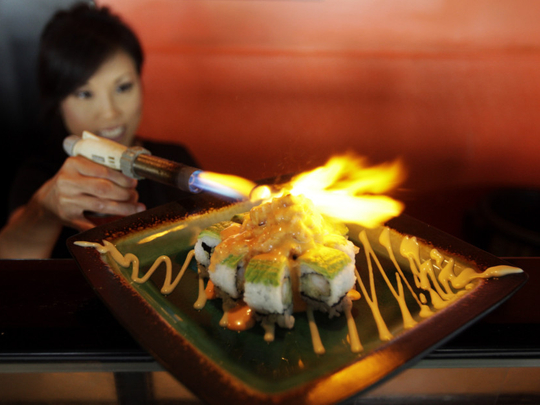
It’s Friday night in Tokyo and a bunch of men are lined up at a bar, having drinks so cold the glasses have frosted over and eating plate after plate of sushi. So far, so normal.
Not normal, though: The chefs making the little slabs of rice and laying the fish on top are all women. In Japan, that’s a sight that’s even rarer than a late bullet train.
But a handful of women are challenging the age-old notion that their gender can’t make sushi.
“I hope that some day it’s not male sushi chef or female sushi chef, just sushi chef,” says Yuki Chidui, the manager of Nadeshiko Sushi, Japan’s first and only sushi bar run entirely by women.
Sushi chefs, like sumo wrestlers and geisha, are stereotypical personifications of Japanese culture.
According to the cliché, they should be old, serious and preferably bald men, as exemplified by Jiro Ono, the owner of a three Michelin-starred sushi restaurant and the subject of the US documentary film Jiro Dreams of Sushi. Called itamae in Japanese — literally, in front of the board — the sushi chef is supposed to deliver a performance and some banter while wielding the knife.
Old notions
Conventional wisdom has it that women can’t be sushi chefs because their hands are too warm or because they’re unreliable at certain times of the month. As Ono’s son Yoshikazu put it in a 2011 interview: “To be a professional means to have a steady taste in your food, but because of the menstrual cycle, women have an imbalance in their taste, and that’s why women can’t be sushi chefs.”
With her flowery blue kimono, long bangs and glittery eye make-up, 29-year-old Chidui certainly does not fit the stereotype. “Sometimes I feel like an animal that’s being watched, but I think of this as a performance and I need to prove myself to them by making good sushi,” she says from behind the counter.
Chidui thinks women have strengths that can work in their favour. “Women have better communication skills, so that helps us connect with our customers and to create a warm atmosphere. And because our hands are smaller, our rolls are slightly smaller. So they’re cuter and easier to eat.”
Still, the all-female line-up feels like something of a gimmick.
Nadeshiko Sushi is located in Akihabara, ground zero for Japan’s otaku or geek culture. The streets of the Tokyo neighbourhood are lined with anime-fronted electronics stores, sex shops and maid cafés — a peculiarly Japanese institution where a young women in a maid’s costume asks customers to meow when they want to order and draws ketchup hearts on the food. Customers must pay to have a photo taken with the maids.
What’s it all about?
Curiosity seems to be the main draw at Nadeshiko Sushi. “I’ve never seen a women’s sushi bar before,” said Tetsu Fuji of Hiroshima, who said he was passing through Tokyo and wanted to check out the restaurant.
Another man at the bar, ruddy-faced Shintaro Hori, said he thought the place was a bit like a sushi maid café. “Men will think that if the sushi is made by a pretty woman, it will taste better,” he said, reaching for another tuna nigiri.
There is some overlap with the maid café genre. The sign in front of Nadeshiko Sushi is pink and says “Fresh and kawaii” (the Japanese word for cute), while the menu stipulates that photos with the staff cost $5 (about Dh18) and that customers must not touch the staff.
The chefs also went through several iterations of uniforms — including maid aprons and outfits worn by popular girl bands — before settling on pretty kimono-style robes called yukata.
More than a few customers get the intent of the bar wrong.
“Sometimes customers come in and think this place is something different. They think this is a girlie bar, and they try to ask for a particular woman to make their sushi,” Chidui says.
Wearing a pink kimono and with long curly hair flowing out from under her bandanna, Miyu Kyoda, 19, has received some unwelcome comments. “Sometimes men ask me to cast a spell on them,” Kyoda says. “They think this is a maid café. It’s because it’s Akihabara.”
Still, she’s happy. “It’s a dream for me to be working here because I want to open my own restaurant.”
Role models
Women like Chidui and Kyoda are pioneers, says Sachiko Goto, principal of the Tokyo Sushi Academy, where prospective sushi chefs can learn the trade.
“There are so few women sushi chefs in Japan,” Goto says. “But when women see good role models, they decide to challenge the preconceptions.”
About one-fifth of the trainees at the academy are women trying to break into the field. The very fact that the school exists is proof of changing times: Sushi skills have traditionally been handed down from father to son and apprentices often spend years doing dishes and taking out the trash before being allowed to hold a knife.
But the ageing population and the difficulty of the work have led to a shortage of highly skilled sushi chefs.
Still, many of the academy’s female graduates see learning how to make sushi as a ticket to finding work overseas. “Generally speaking, kitchens abroad welcome women compared to Japan,” Goto says. “Japanese sushi chefs think their jobs will be taken by women. That’s part of the reason they don’t want to accept women into their workforce.”
There was one man working in the restaurant on a recent Friday night, however. The company president was pitching in because they were short-staffed. He was in the kitchen doing dishes, out of sight.
— Washington Post






